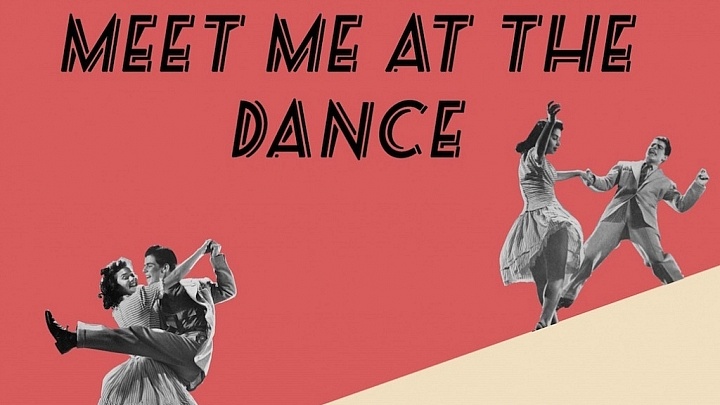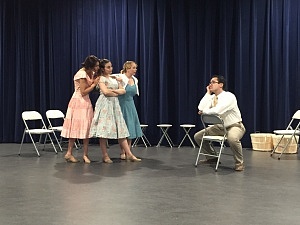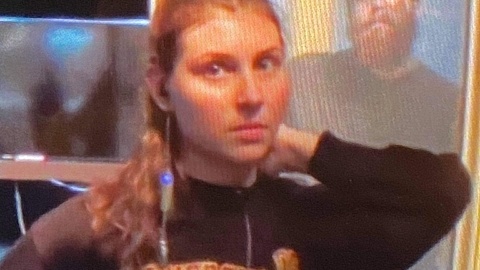It’s been a few weeks since the final performance of Brock University Department of Dramatic Arts’ Fall Mainstage, Scenes from an Execution. Closing off their...
By DART Critics
Caroline Coon writes:
So this is it! After long days of interviewing seniors, scriptwriting, improvisation that usually ended in hysterics, and lots of dance rehearsals, we are in our final week of touring! It’s been an incredible experience, and I’ve learned so much about collaborative theatre. Not only that, but I got to work with an incredible group of people who remind me every day why I chose this path.
Touring has been a whirlwind! We have a total of 23 shows over 12 days, most in retirement homes or long-term care facilities, but a few public performances in community centres. We meet at ECT’s headquarters every morning, caffeine in hand, before jetting off in Shanza’s car to our first show. The AUX cord gets handed over, our favourite playlist starts blasting, Mark pulls up the GPS on his phone, and we’re off! We engage in the same routine—load in, put on costumes, warm up, perform, take off costumes, load out, and get ready for show number two!
Sarah mentions in her video that we spoke to her about the reception we’ve received so far. Overall, it’s been extremely positive, and it’s evident that people do enjoy the show. The difficult part is that when we’re performing for an audience that has a majority of people with physical or mental disabilities, it’s trickier for them to engage fully or give us the energy that we’re used to getting from audiences as performers! We’ve also had to get used to people being disruptive or announcements being read over the intercoms in the middle of the show—it’s certainly not a typical theatre experience!
The performance at Cobblestone Gardens that Sarah attended was definitely one of our better ones. We had interviewed two residents there, who were sitting in the front row, at the same table as Sarah. Everyone was so excited to see us, and the energy in the room was obvious as soon as we stepped in. The space was slightly smaller than we were used to, but we are fortunate to have a set that is easy to condense, and then it was just about being cautious during the dance numbers not to knock into anything.
I was thrilled at how well the audience responded to my character: she can be a little much for some people, but clearly not this crowd! We were getting tons of laughs, lots of people singing along, and at the end everyone had nothing but positive feedback. I was worried going into this show because all week I’d been having difficulties with my voice, so I wasn’t sure if I would be able to project as loud as I need to. Sarah very kindly didn’t mention that I went into a coughing fit during one of the scenes between myself and Mark, but other than that, it went swimmingly.
Sarah’s comments about the roller coaster scene, and how we seemed to be holding back from the noise level. This was a direction that came from Monica. In the beginning that scene was quite loud, with all of us shrieking and yelling, but we decided that the noise level could be overwhelming for the seniors, or it could frighten people who weren’t watching the show.
It’s been wonderful getting to bring this story to a group of people who are often forgotten about. So many seniors and staff expressed their hope that we would return—it feels great to be able to bring them back to their youth through music, dance, and this snapshot of four young people, experiencing love, forming new friendships, and beginning to learn who they want to be beyond high school. The theme of courtship came up so often in our interviews, we couldn’t pass up the chance to explore it further and people have responded so well to it.
I’ve loved having the chance to share my experiences, thanks to Sarah for hopping on board and joining us on this crazy journey! Also special thanks to Mark, Alicia, and Shanza for being the most amazing cast I could ask for; I’ve loved every minute. Thank you also to Monica of course, for giving us this opportunity and helping us create this beautiful story. Also a shout out to Roberta for costuming us–we’ve gotten so many compliments!
Wednesday June 15th
Sarah Bradford Writes: This rehearsal was a real treat as I finally got to witness the full effect of the show with costumes and make-up. The women’s costumes all complimented each other with spring-like colours: Caroline wore a baby blue knee-length dress adorned with pink roses; Alicia’s sparkly dress was a deeper shade of blue with darker blue flowers and a white camisole; Shanza with a white dress embellished with tiny red/pink flowers; and last but not least Mark in a classic white dress shirt, grey trousers, and a beige tie with flecks of red. They all looked like they had just stepped out of the nifty fifties—compliments to DART’s head of wardrobe Roberta Doylend.
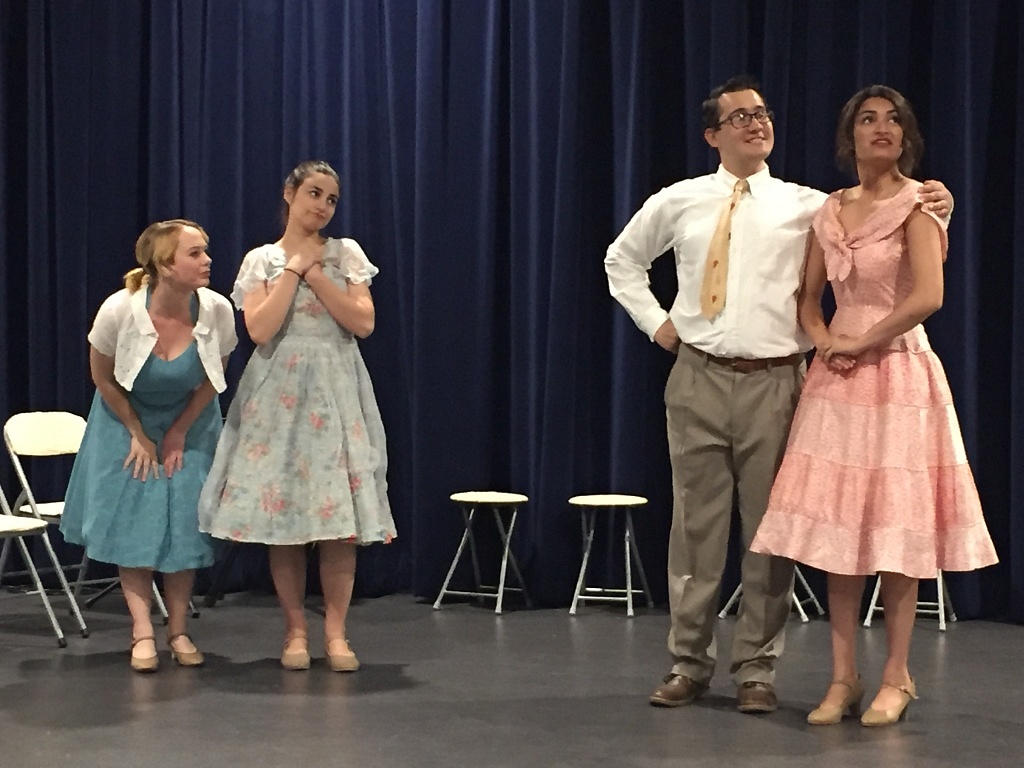
Alicia, Caroline, Mark, and Shanza at the top of the show.
During the run Monica’s husband Kevin took some photos, and set up some static shots afterward. Though I had observed runs of the show prior to this, I was still amazed at the creative ways in which the actors used the stools and chairs to create different scenes/scenarios. One moment they’re bumper cars, the next they are arcade games, a car, or a roller coaster.
To stray away from the usual structure of my previous posts, I’d like to share with you a small interview I conducted with Monica about the show:
Sarah Bradford: What gave you the idea for Senior Stories?
Monica Dufault: When I took over as artistic director of ECT I had this idea about doing a project with seniors and drama students (…) One of the inspirations was that my mom used to work in a long-term care facility. She was a hairdresser so she knew all of the people (…) She had all of these stories about them because they would talk to her as they would get their hair done. I also had a great-grandfather who was an amazing storyteller and a grandmother who was an amazing storyteller (…) I wanted to honour the stories of older adults in the region (…) They get forgotten.
SARAH: Why hire student actors?
MONICA: I was looking for an opportunity to engage students who are just finishing their degree or in the process of doing a degree in theatre with a project that allowed them to actually deal with the public (…) This was a way to put those skills to use that they are learning in university and to have a real-world application for them.
SARAH: How does this year’s project differ from last year’s?
MONICA: Timeline. We didn’t get the funding I had expected and applied for [this year]. I applied for some supplementary funding that I thought would augment the major funding. That meant we could only hire three students for six weeks and we only got word [about] funding a week before we were to start the project so it was very rushed. What that meant was I put the students to work to book the tour and to contact the facilities and set up the interviews. They’ve been doing a lot of the administrative work that last year [was handled by a] tour coordinator. It’s really valuable to learn about marketing, communications, and tour management. Because we only had funding for three positions, we have someone who has volunteered to work with us. So we have four performers, even though we only have three paid positions. Shanza Hashmi is amazing for doing that for us.
SARAH: What lessons did you take away from last years project that you applied to this years?
MONICA: So many lessons! It was the first time (last year) doing [the] project. That time I considered only doing the performance without the interviews, but I don’t think the project works as well. (…) The interview relationship, that opportunity to talk to seniors and to hear their stories, is really valuable and it totally informs how you then shape the stories that you’re going to tell back to them (…) Going forward if we were to do it again I would protect that element of the project because I think its integral to understanding why we are even doing it (…) We all observed last year how impactful it is to do these performance in the long-term care facilities. People who seem to be unresponsive, once the piece begins and they hear the music and they have the chance to observe young people perform for them, it brings them to life.
SARAH: What do you hope people of all ages will take away from this experience?
MONICA: Honouring and valuing the lives that have been lived in this region. It’s a nostalgic way of presenting theatre that has a specific source (…) It’s not art for art’s sake, it’s art that touches people’s lives (…) There is a feeling of universality to the stories and I think lots of people will be able to relate to or feel like they speak to them.
SARAH: As your first shows approach, how do you feel going into them?
MONICA: Last year I wasn’t quite sure what the reception would be in the homes. Now I know what to expect a bit more, so it’s easier to shape the performance with that in mind. I’m really enjoying the stories we have come up with this year; they are really different but they are also very charming and I think they’ll be well received (…) I’m feeling very confident about it and these guys [the actors] are going to be great.
SARAH: Do you think you’ll continue doing the project next year?
MONICA: Yes. We’re going to apply for Trillium funding for a three-year span. If we can get that then it will be so much easier to plan ahead and advertise to the students so they can apply for the positions in plenty of time. June is seniors month, so it’s really great to do performances in June but in order to do that we need to begin the work in the beginning of May.
Monday June 13th
Sarah Bradford writes: “They’re a bit giddy today, Sarah,” Monica says as I return to the usual rehearsal room at the MIWSFPA. As I made myself comfortable in the seat beside Monica’s, my ears were immediately greeted by the pre-show music she had added at the top of the show. I felt like I had entered a 1950s sock hop.
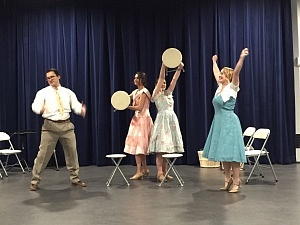
Sandy beats Dave at “The Strong Man” game.
The runthrough got underway and immediately I witnessed some improvements from the last rehearsal I attended: everyone was off book, confidence in the dance steps had increased tenfold, and the character monologues/stories felt more personal rather than rehearsed. While at times the energy and enthusiasm I observed last week seemed to lessen, it was understandable considering Caroline had just stepped off a 12-hour bus ride from New York City half an hour prior. During June’s monologue about the day she knew she was in love with Henry, I found myself transported to a quiet lake on a spring evening—Shanza brings a real honesty to her character and I could see her thought process through the monologue.
I noticed that throughout the course of the performance each character grows and their personalities transform. Laura, Caroline’s character, starts off seemingly vapid and rambunctious. As time goes on and her romance with Dave (Mark’s character) flourishes, a more romantic and vulnerable side to her is revealed. Facing a hard decision between her job and her independence, by the end of the play Shanza’s character June stands up for her own happiness. Sandy, played by Alicia, starts off sheepish and often gets teased by Dave, but her confidence grows as she asserts her importance through her job as an operator for Bell Canada. Monica says that these character developments were a “happy accident” as a result of allowing the stories to shape the characters.
Before I left I asked Monica when their first shows were: “This week!” she said excitedly. It is clear that this project is important to Monica and that she takes pride in being able to produce a performance that is by older adults for older adults. She informed me that their performances will take place from June 15th to June 30th—22 performances at the senior care facilities where they held interviews as well as at community centres, and one final performance at the MIWSFPA.
As usual, I turn it over to my partner on this feature Caroline Coon!
Tuesday June 7th
Sarah Bradford writes: On Tuesday June 7th I entered Studio B at the Marilyn I. Walker School of Fine and Performing Arts with excited anticipation, and learned from Monica that after just three days of creation and minimal rehearsal time, today was the Senior Stories cast’s first time getting the piece on its feet with a physical script.
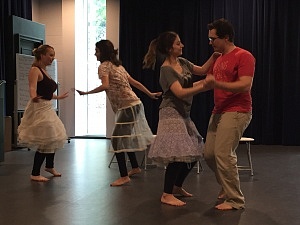
Alicia, Shanza, Caroline, and Mark in rehearsal.
The atmosphere was energetic and playful as the group practiced some choreography. They were in the midst of running through the show’s dance numbers—Caroline seemed to be leading Shanza, Mark and Alicia through the steps. From a traditional two step to an energetic Jive, the dance portion of this rehearsal had me tapping my toes to songs by Bill Hayley and The Comets, Louis Armstrong, and Hank Williams (readers of my generation may need to YouTube these names).
Monica acted as music operator and, aside from a little side coaching, let Caroline and the others take the lead for this portion of the rehearsal. Though the group had come far in just three days, during one of the scenes where each female character dances with Mark’s character, it was obvious that they were still in the “stumble through” period (as Monica called it). The dancing was mechanical and confidence in the steps was wavering—but the amount of fun they were having while learning these new dances was obvious through the mounting laughter.
By the end of what she called this “shindig” Monica had some notes: she wants the performers to feel the music rather than concentrating on being “on beat”; Caroline’s and Mark’s characters need to have more chemistry between them in their dancing (as they are love interests); and during a scene in which the three women sing “To know him is to love him” by The Teddy Bears, Monica told them to “picture yourselves on American Bandstand!” With those notes in mind the group prepared for their first full runthrough.
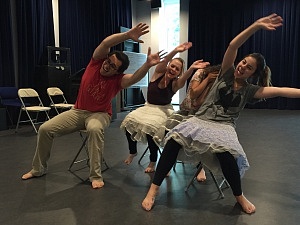
Riding “The Cyclone” at Crystal Beach.
From what I gathered as I observed this run, the story is this. June (Shanza) and Laura (Caroline) are best friends who both lead rewarding careers in their fields: June as a teacher and Laura as a nursing student and model in her spare time. The two are preparing for a night of fun—Laura attempts to coax the uncertain June into attending a dance at the YMCA, but June is hesitant as her boyfriend Henry is away at school and she fears what he would think. Laura gets her way and the two end up meeting their friend Sandy (Alicia) and her cousin Dave (Mark) at the dance. Dave has just moved with his parents from Sudbury to a farm in Pelham—his cousin Sandy has been tasked with showing him around the area, including St. Catharines. What starts as these four meeting at the dance turns into evenings at the cinema, roller coaster rides at Crystal Beach, picnics at DeCew Falls, and a whirlwind of music, laughter, and love.
While at times the actors were scrambling for their scripts and stopping to remember what came next, their energy and enthusiasm didn’t falter. At the end of the run I asked them how many of the characters/events were inspired directly from stories they had heard—Mark said that the entire play captures “the essence” of each story (love, friendship, fun times etc.) but there are some individual monologues and scenes that were taken directly from specific interviews, for example a story involving Sandy as a telephone operator.
As this rehearsal came to a close I found myself already looking forward to my next visit. If after three days they already have a full script I am just itching to see what more they will accomplish in the coming days!
Now it is my pleasure to turn it over to your eyes on the inside, Caroline Coon!
Tuesday May 31st
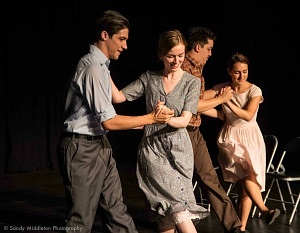
Last year’s “Senior Stories” cast. Photo taken by Sandy Middleton.
Sarah Bradford writes: St. Catharines-based not-for-profit theatre company Essential Collective Theatre prides itself, as it says on its website, on telling stories that hold a mirror to the Niagara region. This phrase rings true when it comes to ECT’s Senior Stories project, developed by artistic director Monica Dufault to give a voice to the elder residents of our area. Begun in May of 2015 with five University students and Dufault traveling throughout Niagara interviewing older adults about their lives, last year’s version resulted in an original show that toured to senior care homes, libraries, and senior living communities.
This summer, Senior Stories is back as Dufault takes on four new students studying Dramatic Arts at Brock University. Caroline Coon, Mark Harrigan, Alicia Bender, and Shanza Hashmi have been conducting interviews at various St. Catharines senior care facilities. While last year’s project focused on interviewees’ youth during WWII, this year’s is focused primarily on life after the war.
Now, you’re probably wondering where DARTcritics fits into all of this. With the permission of Monica Dufault and the Senior Stories cast I, Sarah, have been entrusted to bring you a behind-the-scenes look at what goes into conceiving and creating this original show. And because my fellow DARTcritic Caroline is one of the actors working on the project, she will relay her own experiences in response to my observations via vlog (the first one is at the bottom of this post). So without further ado…
On Tuesday May 31st at 10am I met up with Caroline, Mark, and Alicia outside of the Loyalist Retirement Residence on King Street (Shanza could not make today’s interviews). The four of us entered and were immediately greeted by an employee who raved about last year’s performance and how much the seniors looked forward to this year’s. We were guided to a recreation room where the first of three interviewees, Arlene, sat waiting patiently at a table.
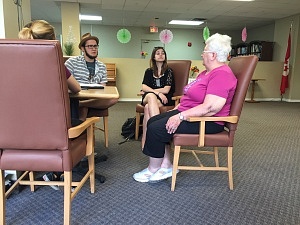
Mark Harrigan, Caroline Coon and Alicia Bender (with back to camera) interview Arlene.
Before the interview began I inquired if it would be all right with her if I took some photos/videos during the interview (each interviewee also signs a media release form). She happily agreed, exclaiming “It’s a good thing I just got my hair done!” Mark, the lead interviewer for this stage of the work, explained to Arlene the nature of the project—it was reiterated that her stories, though they may or may not wind up in the end product, will contribute to the overall creative process and will serve as inspiration and influence on the final performance piece.
I remember once the interview had started I began to sense a feeling of tension around Mark’s questioning. He mentioned to Arlene that this was more of a conversation than an interview, but the questions sounded contrived and at times there were certain pieces of potentially useful material that went unexplored. I pondered if this was due to the fact that this was their last day of interviews—perhaps they were trying to direct the conversation away from topics such as the war and childhood memories and more toward stories about social activities such as dances. This interview, along with Laura’s (the second interviewee), seemed to me to steer in the direction of their occupations.

Alicia, Mark, and Caroline interview Laura.
Laura told the group a bit about her time as a paediatric nurse in Haiti—the children she worked with were often malnourished and died as a result. The group handled this serious turn in the conversation professionally and with great sensitivity. As explained to me prior to this interview, the group goes into each conversation knowing that some of the experiences discussed by the seniors may be negatively charged or emotionally heavy. The interviewer is there to listen, encourage the interviewee to speak only about what they are comfortable with, and offer positive feedback and thoughtful questioning in response.
The third conversation was with a vibrant man named Dave who talked about how he “never grew up.” It was obvious that the group was more at ease in this interview due to Dave’s laid-back nature and many stories of his troublemaking childhood. Most of the interview was spent talking about his eternal love for Walt Disney World in Florida, and the numerous occasions he traveled there from the time he was a child up until today. At the end of his interview, as with the others, Mark asked if he had any advice for young people such as ourselves. “Stay in school” was his advice—he explained that when he was young he was at “the tail end” of a time when a young person could get a job with minimal education. This awareness of the difficulties young people nowadays face as they struggle to find a employment was refreshing to hear.
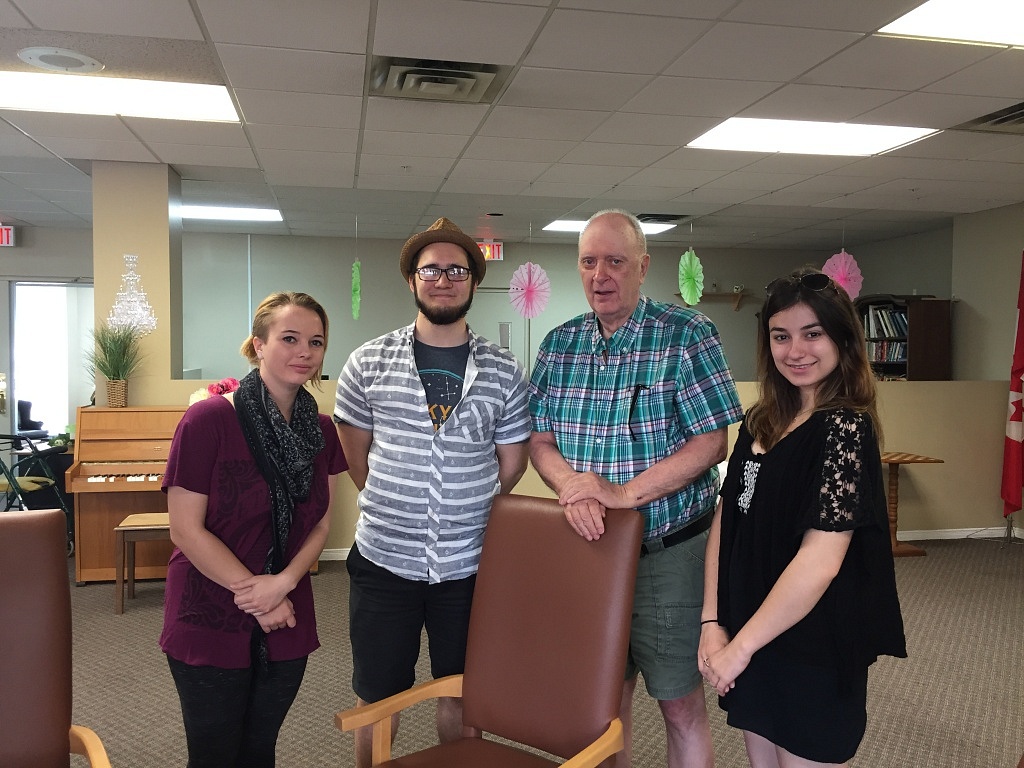
The Senior Stories crew (from left: Alicia, Mark, and Caroline) with Dave.
Dave allowed me to snap a quick photo of himself and the group together before we left.
When I look back now on the memories that each person shared, while engaging to listen to, it’s hard for me to picture how any of the information could be used in the group’s creation process. Most of the stories were about childhood, and what was mentioned of adulthood was mostly about working—it will be interesting to see the body of work the group has collected come together in their rehearsal/creation process.
Now without further ado, I will hand it over to Caroline, who brought along Shanza for her first Senior Stories vlog!
Related Posts
Here’s Holly Hebert’s final solo vlog from behind the scenes of the Fall 2020 DART Mainstage, Scenes from an Execution. She and Asenia will round off this...
In the week before Scenes from an Execution opens, everyone I talked to has wanted to know how it works. We are staging the production online, a convention in...
Here’s Holly Hebert’s final solo vlog from behind the scenes of the Fall 2020 DART Mainstage, Scenes from an Execution. She and Asenia will round off this...
In the week before Scenes from an Execution opens, everyone I talked to has wanted to know how it works. We are staging the production online, a convention in...
Leave a Reply (Cancel Reply)
Twitter Feed
Blogroll
DARTcritics.com is partially funded by the Marilyn I. Walker School of Fine and Performing Arts, in support of student learning; experiential education; student professionalization; public engagement with the teaching, learning and production activities of the Department of Dramatic Arts; new ways of thinking; and the nurturing of links with our communities.

